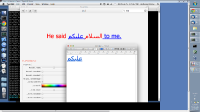1. Run Ensemble8 and navigate to the Bidi demo (in Controls)
2. In the Properties section check the "...to me, underline" option, and observe that the blue text is now underlined.
3. Note that there is a character in the first (Arabic?) part of the blue string that has two dots under it. The underline option seems to almost completely hide the two dots, making them very hard to recognize.
4. Now navigate to the source code of the demo and cut'n'paste the text of the label. Use a converter to convert it to a unicode string (e.g. I used http://itpro.cz/juniconv/ ).
5. Cut'n'paste the unicode Arabic characters into a text editor (I used TextEdit on Mac).
6. Select the string in the native text editor and also underline it by clicking a button on the formatting toolbar. Increase the font size if needed (I used 24 pt).
7. Observe that the native application renders the underlined character so that the two dots underneath are clearly visible (the line that underlines the text kind of terminates before the character and continues afterward).
I don't speak Arabic language and can't tell if the two dots are essential or not for understanding the text, however, I do observe that native apps render underlined text differently. making it easier for native speakers to clearly see all the characters. But JavaFX seem to be doing this somehow wrong.
2. In the Properties section check the "...to me, underline" option, and observe that the blue text is now underlined.
3. Note that there is a character in the first (Arabic?) part of the blue string that has two dots under it. The underline option seems to almost completely hide the two dots, making them very hard to recognize.
4. Now navigate to the source code of the demo and cut'n'paste the text of the label. Use a converter to convert it to a unicode string (e.g. I used http://itpro.cz/juniconv/ ).
5. Cut'n'paste the unicode Arabic characters into a text editor (I used TextEdit on Mac).
6. Select the string in the native text editor and also underline it by clicking a button on the formatting toolbar. Increase the font size if needed (I used 24 pt).
7. Observe that the native application renders the underlined character so that the two dots underneath are clearly visible (the line that underlines the text kind of terminates before the character and continues afterward).
I don't speak Arabic language and can't tell if the two dots are essential or not for understanding the text, however, I do observe that native apps render underlined text differently. making it easier for native speakers to clearly see all the characters. But JavaFX seem to be doing this somehow wrong.
